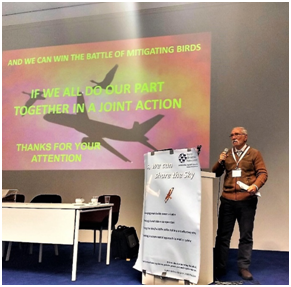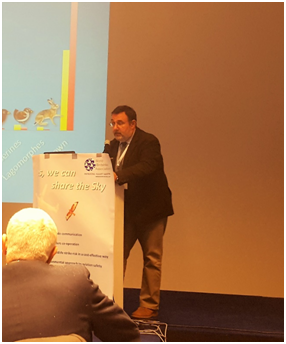 it
it  en
en
Archive 2016
The event occurred in Melbourne on November 29 (see below) reopens the (never- closed) chapter of the absence of abnormal parameters after a bird strike. In summary, the crew is aware theyimpacted one (or more?) bird on take-off but, in the absence of abnormal instrumental indications, continued to fly for 10 hours across the Pacific to Hawaii. It should be known (another point to explore) that a bird ingestion into an engine can cause malfunction signals hours and even days later and only an endoscopic inspection can determine whether the engine suffered damage and whether it is suitable for flying. Another point that should be clear is that, supposing the aircraft suffered multiple impacts, the doubt that also the second engine may have been affected, this time without notice, should automatically arise in the crew minds.
In this case, the engine had to be replaced after landing, a sign that the damage was substantial and not repairable on site. It’s true however that the damaged engine continued to properly run for hours, but just the doubt that also the other one could have been affected, should have led to a greater caution.
Caution, however, originates from the education and the training received and the question is, alsogiven specific precedents, which kind of training the pilots receive with regard to bird impact and / or ingestion?
The most egregious precedent regarded the crew of a PAL B777 that on 15.4.2011 flew from Manila to Vancouver and discovered only after landing that one of the engines had been damaged following a bird ingestion and needed to be disembarked and replaced.
But several other cases are reported (British Airways Orlando- Gatwick, Thomas Cook Istanbul- London etc...) that disclose the inclination of the crews, in the absence of specific training and a company policy, to trust too much in the “absence of abnormal parameters”.
Unless the costs of a prudential return in terms of fuel, time and image do not subconsciously exceed the attention to safety so that one could suppose that "safety first, but after profit"
- 2 October – Orlando (FL)
American Airlines A321, on final approach a bird impacted the aircraft just below the windshield; minor damage as result of the bird strike; - 3 October – Pristina (Kosovo)
Swiss A320 in the initial climb anengine ingested a bird prompting the crew to immediately return about 15 minutes after departure; - 6 October – Milan (Linate)
Alitalia A320flew through a flock of birds shortly after departure; the crew heard an impact, however, in absence of abnormal indication, decided to continue the flight to destination; - a post flight inspection revealed a bird had struck an engine case; return flight cancelled and aircraft grounded for about 30 hours;
- 6 October – San Francisco (CA)
Qantas B747, during the initial climb the crew heard abnormal noise and sensed unusual vibrations of the aircraft; after consulting with maintenance and in the absence of any abnormal indications the crew decided to continue to Sydney in a 14 hours flight; a post flight inspection revealed a bird strike to a landing gear door strut and the door seal; - 11 October – Portland (OR)
Southwest Airlines B737 rejected takeoff at high speed due to multiple impacts with birds; an engine sustained substantial damage as result of birdstrikes; - 15 October – Kathmandu
Buhtan Airlines A319, was on final approach when a goat reached the runway prompting the crew to go around; the animal, belonging to the army battalion responsible for airport security, was caught and removed from the aerodrome perimeter in order to allow the landing of the aircraft; - 16 October – Salt Lake City (UT)
Delta B737, multiple bird strike on final; minor damage; - 19 October – Probably Istanbul (SabihaGokcen)
BoraJet ERJ195, enroute at FL360 in a flight to Manchester the captain windshield started to crack due to a bird strike; the crew then decided to divert to Budapest; being almost impossible that a bird strike occurred at that altitude, it is probable that the impact happened at departureand the windshield cracked later on during the flight; - 21 October – Rochester (NY)
FedEx B767, after take-off the crew decided to return for landing in order to assess possible damage to the flaps; in the meanwhile the TWR reported the presence of dead birds on the runway, impacted by the aircraft; no damage found after the post flight inspection; - 21 October – Sao Paulo (Guarulhos)
TAP Portugal A330, upon rotation a bird impacted the left engine; the crew continued the climb but later decided to dump fuel and to return for landing about one hour later; substantial damage to the engine; - 21 October – Ft. Lauderdale (FL)
Southwest B737, rejected take off at high speed due to a bird strike; one engine damaged; - 29 October – Chicago (O’Hare) (IL)
Envoy CRJ700, multiple impact during the initial climb; immediate return; damage to the fuselage; - 1 November – Amsterdam
KLM B737, immediately after take-off the crew reported the right engine failure due to the ingestion of at least 8 birds; immediate return about 25’ later; several dead birds found on the runway; - 2 November – Dusseldorf
Lufthansa A321, rejected take-off at high speed in order to avoid flying through alarge flock of geese that was going to cross the aircraft departure path; - 5 November – Hong Kong
Tigerair A320, during the initial climb suffered a bird strike on the Captain’s windshield, which remained cracked and arcing; immediate return 70’ later; - 5 November – Lahore
PIA A320, during the initial climb an engine ingested a bird; immediate return after 15’; fan blades damaged; - 8 November – Banjul (Gambia)
Thomas Cook A321, flew through a large flock of storks at rotation (V1) and ingested a number of birds into both engines while other birds struck the aircraft in several points; after take-off the right engine began to vibrate significantly and had to be shut down; the aircraft came to landing 45’ later; a post flight inspection revealed a bird hanging from the right main gear; 13 dead birds found on the runway; it is the third case of the year of bird ingestion into both engines;
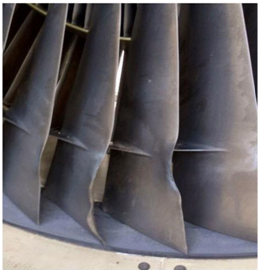
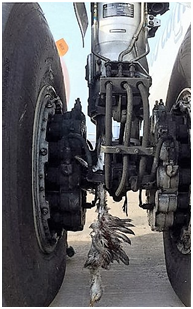
(Photos by Kayleigh Loveridge taken from Avherald.com) - 9 November – Bremen
Germanwings A319, birdstrike during the initial climb and immediate return; - 10 November – Buenos Aires (Aeroparque)
AerolineasArgentinas B737, on final a bird impacted the nose cone;
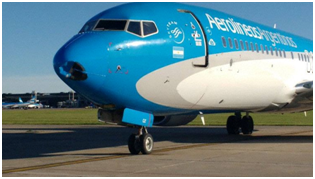
(Photo by Guille taken from Avherald.com) - 10 November – Rio de Janeiro (Dumont)
AviancaBrasil A318, on final at 2000 ft. struck a vulture; - 16 November – Btn Dammam and Jeddah
Saudia A330, after landing the aircraft was prepared for the next flight and a hole was discovered in the leading edge of the left hand wing with a bird embedded; it is a Greater spotted eagle (Clangaclanga) that can weigh up to 3 kilos;
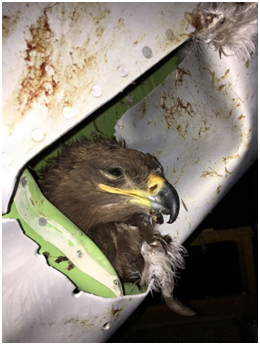
(Photo taken from Avherald.com) - 19 November – Saint Louis (MO)
American B737, on take-off struck several birds a number of which have been ingested into the right engine; substantial damage to the engine and the fuselage; immediate return 25’ later; debris found on the runway; - 20 November – Santiago de Compostela
Easyjet Switzerland A320, on approach flew through a flock of birds and suffered damage to the fuselage; return flight operated by another aircraft; - 20 November – Cape Town
Condor B767, rejected takeoff at about 110 knots due to a bird strike into the right engine; the right hand brakes overheated causing the tyres to deflate; - 23 November – Azur B767
Moscow (Domodedovo), during the initial climb an engine ingested a bird prompting the crew to burn fuel and return for landing about 2 hours later; - 24 November – Burbank (CA)
Southwest B737, on final suffered a multiple impact with birds that caused minor damage; - 25 November – Istanbul (SabihaGokcen )
Pegasus A320, bird strike at take-off and immediate return 25’ later; - 26 November – Phuket
Eurowings A330, rejected take-off at high speed further to a bird ingestion into the right engine; aircraft replacement and flight delayed for 27 hours; - 28 November – Istanbul (Ataturk)
THY A321, bird strike at take-off and bird ingestion into the left engine; immediate return 17’ later;
http://www.goklerdeyiz.net/thy-antalya-ucagi-geri-dondu - 28 November – Daytona Beach (FL)
Delta MD88, rejected take-off further to multiple bird impacts to an engine; damage to the engine and the nose gear lights; - 29 November – Melbourne
Jetstar B787, in the initial climb a bird struck the aircraft; in the absence of abnormal indications the crew decided to continue the flight to destinationfor about 10 hours; a post flight inspection revealed that one of the engines received bird strike damage requiring an engine change; - 4 December – Memphis (TN)
Southwest B737, in the initial climbthe crew reported a bird strike; they had a couple of feathers on the windshield and believed a bird may have hit the flaps; immediate return about 20’ later; - 5 December – Memphis (TN)
Delta MD88, in the initial climb the crew reported a bird strike into the left hand engine, declared emergency and shut the engine down; immediate return about 20’ later; - 5 December – Newark (NJ)
Republic Airways ERJ170, a bird struck the radome during the approach; damage to the nose cone; - 7 December – between Dubai and Warsaw
Emirates B777, a post flight inspection revealed the aircraft had received a bird strike and was unable to depart for the return flight that was cancelled; - 12 December – Amsterdam
Vueling A320, rejected take off at low speed due to a bird strike; the aircraft was able to depart for the flight about 75 minutes later; - 14 December - Prague
Lufthansa A320, rejected take off at low speed due to a bird ingestion in the left engine; the aircraft was able to depart for the flight about 115 minutes later; - 15 December – Chicago (Midway)
Southwest B737, during the initial climb an engine ingested a bird and began to vibrate; the crew declared emergency and returned for landing 10’ later; - 15 December – Chicago (Rockford)
Allegiant A320, during the initial climb the aircraft flew through a flock of geese and ingested a number of birds into the left engine; the crew shut the engine down and returned for landing about 25 minutes later; - 21 December – Johannesburg (Lanseria)
Mango B737, during the approach the left engine ingested a number of birds;
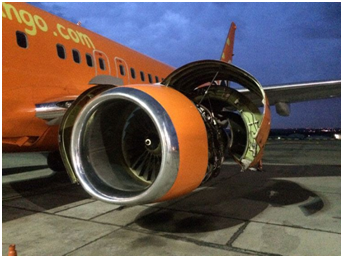
(Photo taken from Avherald.com) - 21 December – Tampa (FL)
Delta MD90, during the approach a bird impacted the nose cone causing a large hole; - 22 December – Porto Alegre
LATAM A319, during the approach a bird was ingested into the left engine; - 23 December – Lahore
PIA B777, during the approach a bird was ingested into the left engine; - 28 December – Ft. Lauderdale (FL)
Virgin America A320, on final the left engine ingested a bird and suffered damage; - 29 December – San Francisco (CA)
American Airlines B737, upon rotation a number of small birds impacted the aircraft; in the absence of abnormal parameters the crew continued the flight to destination for 3,5 hours; after landing an inspection revealed the aircraft suffered damage and had to be grounded due to numerous bird impacts; - 30 December – Warsaw
Enter Air B737, during the initial climb the right engine ingested a bird, emitted a loud bang and lost power; the crew decided to return for landing, burnt off fuel and landed back about 2:15 hours after departure; - 31 December – Malaga
Vueling A320, rejected take off at high speed further to a bird ingestion into an engine;
Finally, after two postponements, the long-awaited meeting of the WBA took place, hosted in the rooms of the Royal Netherlands Navy Command in Amsterdam. Despite the very short time (less than three months) to reorganize the event, originally scheduled in Muscat (Oman), the conference was a great success and was attended by about 150 members both civilians and military.
The meeting lasted five days, the first three devoted to the presentation of documents by the participants
(http://www.worldbirdstrike.com/index.php/component/content/article/47-resources/169-amsterdam-presentations-2016)
and the following two to the deepening of some topics, having in view the date of May 2017 when the ICAO, the world's foremost aviation organization, will organize its own conference specifically dedicated to the problems of wildlife strikes (ICAO / ACI Wildlife strike Hazard Reduction Symposium). The occasion was so propitious for an exchange of ideas among the world's leading experts in order to present joint proposals and direct ICAO towards the needed actions for the prevention of this always-growing phenomenon.
Italy was represented by an official delegation made up of Ing. Claudio Eminente, ENAC Deputy Central Director and current chair of the Bird Strike Committee Italy and Dr. Alessandro Montemaggiori, ornithologist on contract in the same Agency. The Italian Air Force was represented by LT.Col. Filippo Conti.
Dr. Valter Battistoni was also present on behalf of STASA - Research Centre, former chair of the BSCI and manager of this website.
The ENAC delegation presented a report on the application of BRI (Birdstrike Risk Index) in the Italian airports, while Dr. Battistoni solicited an improvement of the certification requirements for transport aircraft. In particular, he focused on some past incidents highlighting the opportunity to better shield the nose gear steering apparatus, the window and the window frame, guaranteeing in the same time its natural function (i.e. visibility), and suggesting to increase the size of the birds used to establish the airframe resistance standards.
(Valter Battistoni (above) and Alessandro Montemaggiori during their presentations at the meeting)
It also proposed some changes that ICAO should make to its regulations (Annex 14 para 9.4.1) by inserting the obligation to specify in the reports the bird species impacted. This would be a big aid for implementing specific plans aimed at limiting the hazard. Moreover ICAO should update its IBIS system (ICAO Bird Strike Identification System) and make it accessible to the community of operators and researchers, as well as make it compatible with the European system of data collection ECCAIRS (European Coordination Centre for Accident and Incident Reporting System ).
Finally, as for the information to the pilots on the presence of birds, given the substantial uselessness of NOTAMs, the conference proposed the use of a proper phraseology just limited to the quantification and localization of birds, possibly communicating their species and the movement direction, leaving to the crew the task of assessing the risk level related to their presence.
The BSCI, a branch of the Italian Civil Aviation Authority (ENAC) released its 2015 Report on the phenomenon of wildlife strikes in Italy. As usual, we present here our observations and comments (a short summary in English).
- 1 July – Faisalabal (Pakistan)
Flydubai B737, during the approach a bird struck the aircraft nose; - 3 July – Paphos
Ryanair B737, rejected take off due to a bird ingestion into one engine; - 4 July – Sydney
United Airlines B787, at about 1000 ft. flew through a flock of birds two of which hit an engine; even in the absence of abnormal indications the crew decided to return one hour laterafter having dumped fuel; flight cancelled; - 6 July – Kazan
S7 Sibir Airlines A319, during the approach a bird hit the aircraft nose; return flight delayed for 9 hours; - 7 July – Kathmandu
Nepal A320, during the initial climb the right engine ingested a bird; immediate return; - 10 July – Kiev (Zhulyani)
Wizzair A320, bird strike with ingestion on landing (see specific article); - 10 July – Toulouse
Brussels Airlines A319, during the final approach a bird struck the aircraft nose at about 1000 ft.; the crew went around and made successfully a second approach; return flight cancelled; - 10 July – Cold Lake (Canada)
Canadian North B737, struck several birds during the flare before touch down at less than 50 ft.; minor damage; - 15 July – Lajes
Azores Airlines A320, after take-off a bird hit an engine causing its failure; immediate return about 15’ later and flight cancelled; - 21 July – Liverpool
Easyjet A320, during the initial climb a bird was ingested into the left engine causing a loud bang and a brief loss of power; he engine however fully recovered resulting in all instruments showing normal values and the crew decided to continue to the destination; 50’ later however they decided to divert to another airport; - 24 July – London Gatwick
Easyjet A319, during the initial climb the crew suspected a bird might have impacted the aircraft; in the absence of any abnormal indications the crew continued the flight that ended regularly; the aircraft was however unable to depart for the return flight that was cancelled; - 28 July – Praia (Cape Verde)
TAP A320, at rotation the right engine ingested multiple birds; immediate diversion to other airport with longer runway and flight cancelled; - 5 August – Bremen
Germania A321, during the initial climb an engine ingested birds and emitted two loud bangs and streaks of flame; immediate return with only one engine; - 9 August – Amsterdam
KLM B737, rejected take off at high speed due to a bird strike; the aircraft taxied back to the apron and reached its destination with a delay of 2,5 hours; - 11 August – Glasgow
Thomas Cook A321, shortly after take-off an engine ingested a bird; immediate return; - 12 August – Auckland
Air New Zealand A320, bird strike on final approach; next flight cancelled; - 13 August – Denver (CO)
during the initial climb the left engine ingested a bird; immediate return about 20’ later; flight cancelled; - 15 August – Hanoi
Vietnam Airlines B777, during the initial climb flew through a flock of birds a number of which were ingested into the left engine that needed to be shut down; immediate return; - 15 August –Brasilia
AviancaBrasil A320, during the initial climb an Urubu (Coragypsatratus) impacted the nose of the aircraft and remained stuck; immediate return and flight cancelled;
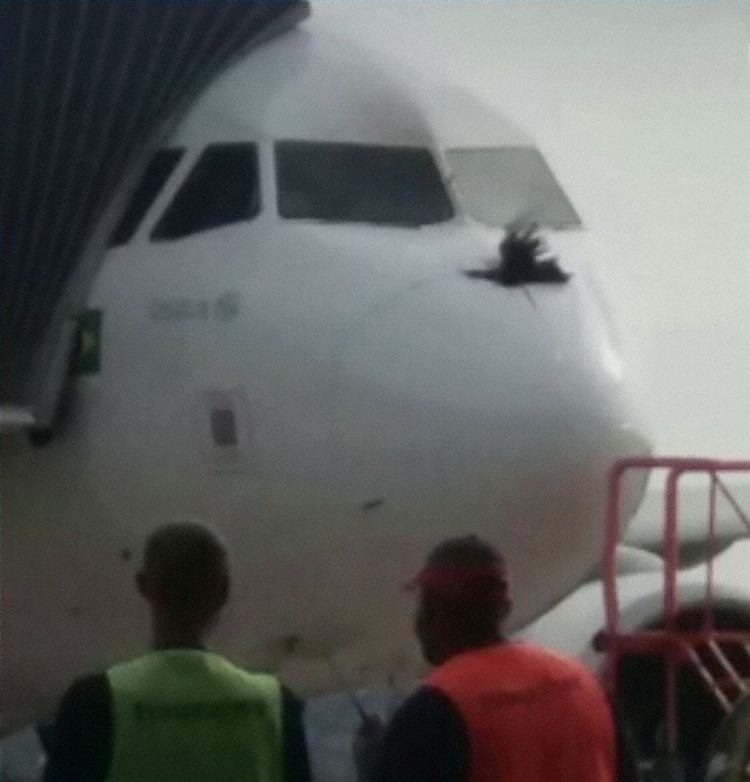
(Photo taken from Avherald.com) - 16 August – Shenyang
China Eastern A320, on approach a bird struck the nose cone;
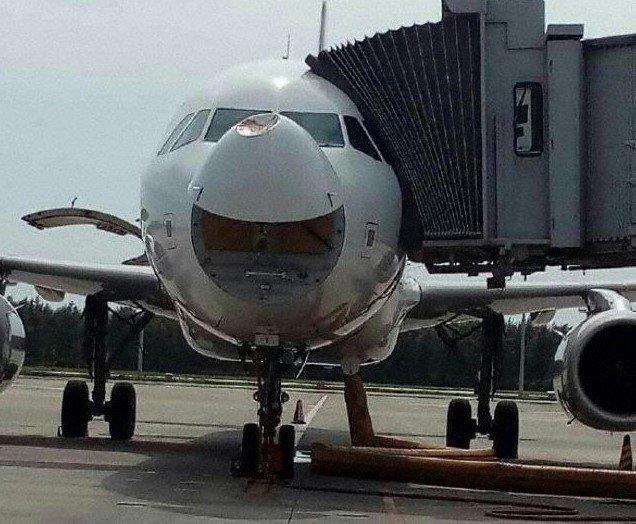
(Photo taken from Avherald.com) - 17 August – Alghero
TUIfly Nordic B737, during the initial climb in a night flight flew through a flock of birds and ingesteda number of them into one of the engines causing damage (bent fan blades) to the engine; immediate return and flight delayed by about 16 hours; - 18 August – Istanbul (Ataturk)
Qatar A330, just after becoming airborne prior to gear retraction the left engine ingested one or more birds that caused a series of bangs and streaks of flame seen both by passengers and ground observers; due to the absence of abnormal engine indications the crew initially assumed a tyre had burst, subsequently received information from the passengers that the left hand engine was on fire and landed immediately with only one engine; the left engine however needed to be replaced; - 18 August – Fuzhou (China)
Fuzhou Airlines B737, during the initial climb a bird impacted a pitot tube causing disagreeing speed data; returned after having burnt off fuel;

(Photo: Fujian Channel tratta da Avherald.com) - 18 August – Buenos Aires (Aeroparque)
AerolineasArgentinas B737, during the approach a bird impacted the nose of the aircraft;
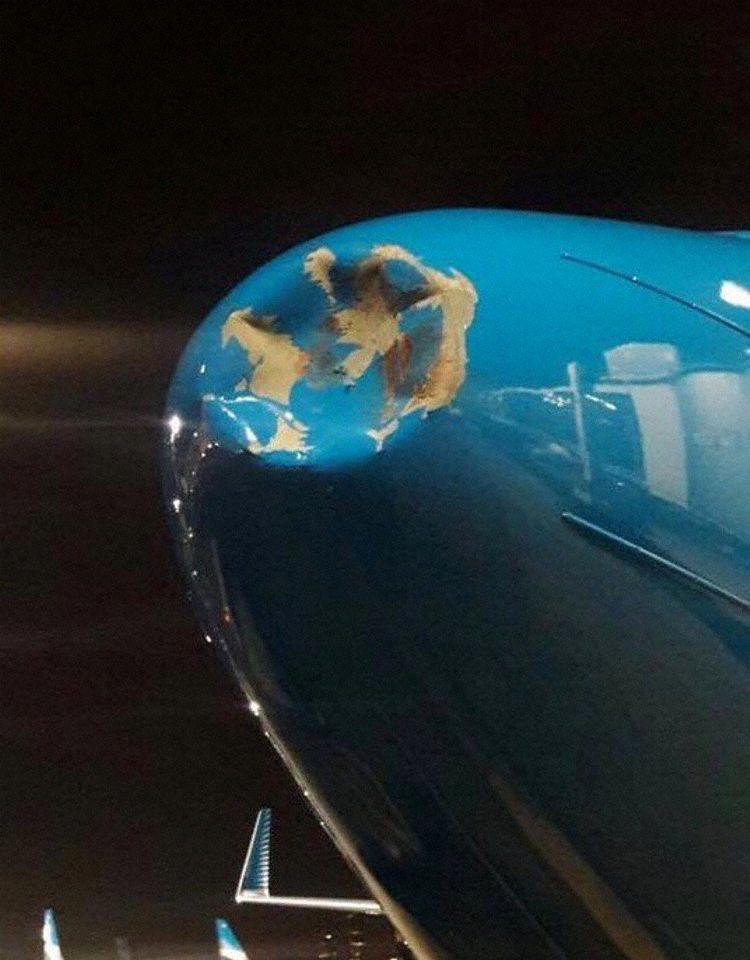
(Photo taken from Avherald.com) - 19 August – Manila
China Airlines B747, the aircraft flew through a flock of bird during the final approach and a bird impacted the aircraft at the left flaps; following landing it was discovered the bird had impacted and penetrated a wing resulting in a small hole; next flight cancelled;
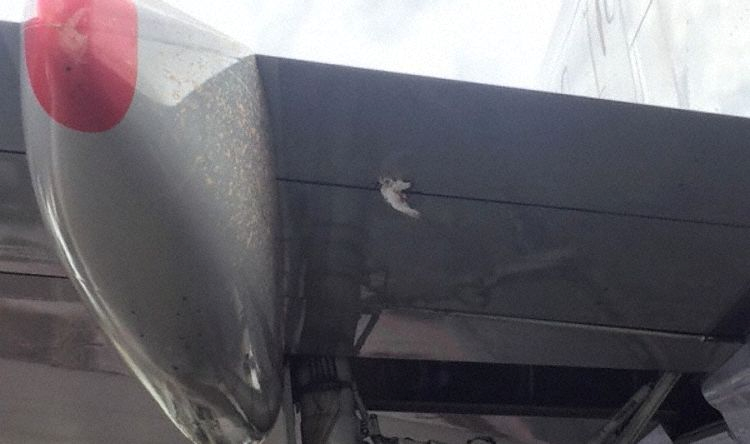
(Photo taken from Avherald.com) - 19 August – Tomsk
Aeroflot A321, during the rollout after landing the right engine ingested a bird that caused damage; next flight cancelled; - 21 August – Salt Lake City (UT)
Compass Airlines ERJ175, on final a bird struck the aircraft’s nose; minor damage; - 23 August – Pune (India)
Spicejet B737, rejected take-off due to a bird strike; flight delayed for 6,5 hours; - 24 August, Birmingham
Thomson B737, after take-off the crew suspected a bird strike, stopped the climb and then returned for landing; after a routine inspection the aircraft departs again with a delay of 2 hours; - 24 August – New York (JFK)
Singapore Airlines A380, landed through a flock of birds at least 100 of which were found dead on the runway after an inspection; the crew reported normal engine parameters however, claiming the flock avoided the aircraft that did not suffer any impact; despite this the return flight departed with a delay of 11 hours; - 28 August – Brno (Czech Rep.)
Smartlynx A320, rejected take off at high speed further to the ingestion of a bird into the right engine stopping 300 mt.before the runway end; - 29 August – Copenhagen
Delta Airlines B767, during the initial climb the TWR told the crew they observed a fire ball from the left engine at take-off; the crew decided to return despite all parameters were normal; - 29 August – Amsterdam
KLM ERJ 190, during the initial climb the crew reported they suffered a bird strike to the landing gear and they needed to return; - 29 August – Durban
Qatar Airways B787, on approach a bird impacted the nose cone; the aircraft remained on the ground for 31 hours for maintenance then flew back to its base with a ferry flight;
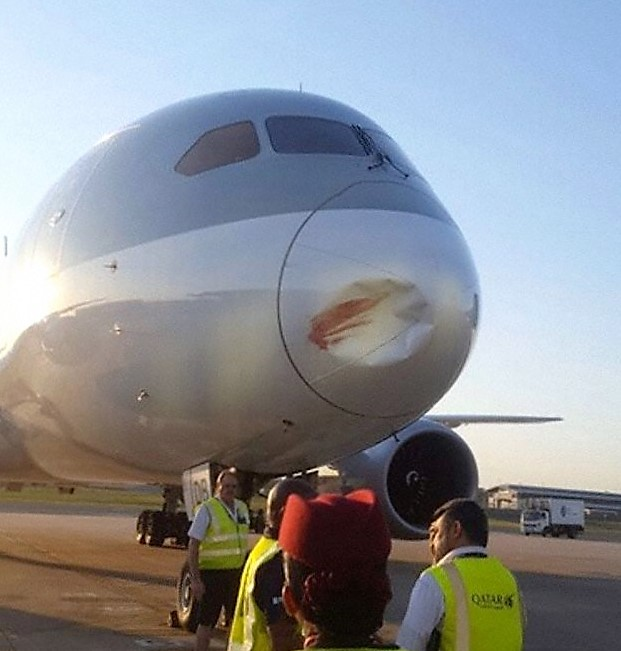
(Photo taken from Avherald.com) - 30 August – Amsterdam
Easyjet A319, suffered a bird strike on landing that caused the aircraft grounding for 27 hours; - 4 September – Asmara
FlyDubai B737, during the initial climb the aircraft flew through a flock of birds and received a number of hits to the radome, an angle of attack sensor and an engine inlet; immediate return; - 5 September – Baltimore (MD)
WOW Air A321, on final flew through a flock of large birds, probably geese, one of which hit an engine causing some vibrations; - 7 September – Sendai
J-Air ERJ190, during the initial climb the right engine ingested a bird; immediate return; - 10 September – El Fasher (Sudan)
Tarco Airlines B737, on approach a large bird impacted and penetrated the nose cone of the aircraft and became embedded;
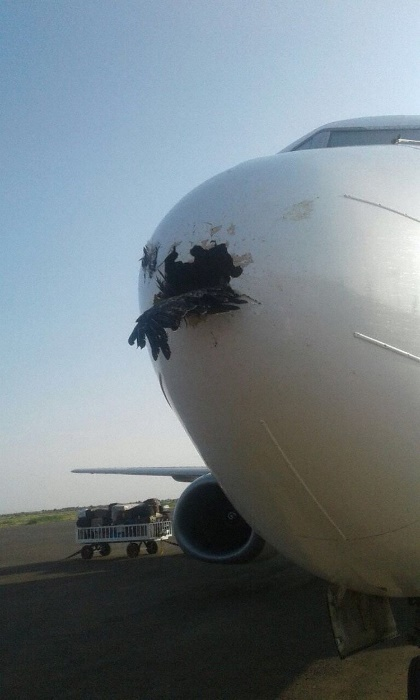
(Photo Usamah Mohamed, taken from Avherald.com) - 13 September – London (Heathrow)
Delta B767, during the initial climb the right hand engine ingested a large bird and began to run rough; immediate return and flight cancelled; - 13 September – Vilnius
Lufthansa A320, rejected take off at low speed due to an animal on the runway; - 13 September – Denver
Compass Airlines ERJ175, during the approach a bird shit the wing leading edge; minor damage; the aircraft was unable to resume service for the next leg; - 14 September – Tallinn
Lufthansa A320, rejected take off at high speed due to a bird strike; no damage; - 15 September – Palma Mallorca
Lufthansa A320, on approach to Palma's runway 24L descending through 5000 ft. a vulture impacted and penetrated the nose of the aircraft and became embedded; return flight cancelled;
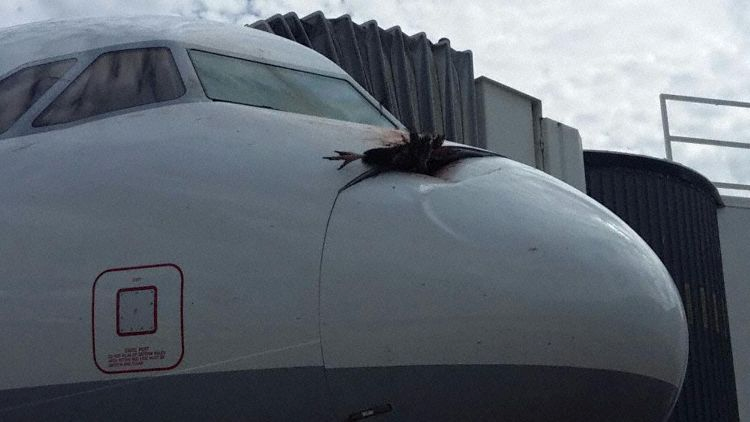
(Photo ConradoAviacion taken from Avherald.com) - 16 September –Bourgas
Wizz Air A320, rejected take off at high speed (110 kts) due to a bird strike; - 19 September – Portland
United B737, on final approach the crew reported smoke in the cockpit adding subsequently that the right hand engine was damaged; after landing the crew then indicated that both engines had been damaged; an inspection revealed that the aircraft received minor damage to one wing and both engines due to a bird strike; - 20 September – Salt Lake City (UT)
Delta A319, during the initial climb an engine ingested a bird that caused the engine stall; when returning for landing the crew initiated a go around advising they now needed to shut the engine down; substantial damage; - 21 September – Rotterdam
Transavia B737, during the initial climb an engine ingested a bird that developed vibrations; the crew decide to land immediately in another airport; the damage is being assessed; - 24 September – Bogota
Avianca A319, at take off the left engine ingested a number of birds; the aircraft burnt off fuel and returned to the departure airport after about 3 hours; - 24 September – Newark (NJ)
American B737, during the approach a bird impacted the aircraft's vertical tail and rudder; unknown damage; - 25 September – Denver (CO)
United B737, rejected take off at low speed after the crew reported a bird strike into the landing gear; the FAA stated the bird strike occurred into the left engine; - 25 September – Memmingen
Wizzair A320, rejected take off at high speed due to a bird ingestion into the right engine; - 27 September – Multan (Pakistan)
Flydubai B737, on approach the right engine ingested a bird; return flight not operated; - 29 September – Boise (ID)
Horizon Airlines Dash 8, bird strike on final approach; minor damage; - 29 September – Cordoba (Argentina)
Austral ERJ190, during the initial climb the right engine ingested a bird that caused vibrations; immediate return and flight cancelled;
On September 9, 2016, Warner Bros released the movie “Sully: The Untold Story of the Miracle on the Hudson”, based upon the ditching on the river Hudson of an A320 following the ingestion of Canada geese in both engines and their switch off.
The Bird Strike Committee USA published the following paper on regard of it
in which some questionable statements can be found, like “wildlife strikes are relatively unusual events”, and “strikes that result in aircraft damage or injuries are rare”.
Statements supported by statistics, concerning only the USA however, probably aimed at reassuring the American public opinion rather than seriously debate this issue so important for air safety.
With regard to this, we can only add that every month worldwide there are at least about a dozen of cases of bird ingestions into one engine, while at least five dual ingestions, i.e.when both engines (of a twin-engine) are affected, occurred in 2014. Bird ingestions have also caused accidents with the loss of over 160 lives since 1960 and the Hudson event was really close to be a catastrophe.
Are they rare events? Of course they are, if compared to the global number of flights, but why for natural phenomena that so far did not cause victims, such as the volcanic ash, authorities did not hesitate to close the skies of half Europe with huge costs?
Since a long time we are complaining the lack of attention and the few resources dedicated to the prevention against bird strikes: comments like these from BSC USA certainly do not help.
Mark Twain used to say:“There are three kinds of lies: lies, damned lies and statistics”.
Wanting to demonstrate the effectiveness of infrared systems as an alternative to avian radars, the FAA, in partnership with the Port Authority of New York and New Jersey, is planning to install an “Interceptor” device, manufactured by Pharovision (www.pharovision.com), at La Guardia airport.
“The system comprises a thermal imaging camera, a high resolution daylight charged coupled device (CCD) camera and an image processing computer. The FAA hopes to establish whether delivery of“Interceptor” data, and the quality of information itself, can be sufficient for an air traffic controller to modify the flight paths or delay aircraft departures in order to prevent birdstrikes.
One challenge facing deployment of this type of system is its integration into the daily operations of controllers. The FAA is in the early stages of establishing a concept of operations for incorporating wildlife detection systems in air traffic operations.” (*)
That’s what we hope for since a long time: the tactical function of the remote sensing devices that include the active involvement of air traffic control in bird strike prevention.
Two months before the planned date the World Birdstrike Association has cancelled the meeting that had to be held in Muscat (Oman) from 5 to 8 December 2016.
The reasons of this sudden decision would lie in too many financial and organizational problems they had to face.
The WBA was self-established in 2012, with an abnormal procedure, during the last meeting of the International Bird Strike Committee, the historical organization that for several decades was in charge of the problem at a global level.
On 10 July, the crew of a Wizzair A320 during the landing in Kiev (Zhulyani) observed some birds on the runway. The routine post flight inspection revealed traces of bird ingestion into the right engine but onlya minor damage was visible. After this visual inspection, technicians postponedtheboroscopic inspection at the next overnight stop and released the aircraft for another two routes, from Kiev to Larnaca and back. Both flights took place regularly without any anomaly. Finally, during the overnight stop at the airline base the boroscopic inspection revealed significant internal damage to the engine requiring its replacement beforethe aircraft could fly again.
The case is almost identical to that occurred on 2012 to an Air New Zealand A320.Also in that circumstance maintenance engineers inspected the engine in accordance with the Airbus aircraft maintenance manual and released it back into revenue service later the same day. The Airbus aircraft maintenance manual required parts of the engine to be inspected using a borescope. However, as the bird strike had involved only one engine and no damage had been observed, the aeroplane was allowed to continue its service for up to 10 hours’ flying or one more sector (one more take-off and landing), whichever came first. The engine was then required to undergo the borescope inspection. Therefore, the aeroplane was released to fly under this “continued operating allowance”. On approach to land at Auckland International Airport the same engine suffered a failure due to the internal damage.
The event occurred to Wizzair seems to be the second occurrence reported worldwide in four years of a V2500 engine that required substantial work despite this “continued operating allowance” after a bird ingestion in the engine "core".
A few remarks: if the continued operating allowanceis released only for another take-off and landing, in the case of Wizzair this limit seems to have been exceeded. In addition,flying through a flock of birds and suffering an ingestion is a frequent occurrence as well as not immediately detecting abnormal engine parameters by the crew; therefore, the actual possibility that both engines might have ingested birds should lead to a greater caution in release the aircraft to commercial service without a proper boroscopic inspection.
- 1 April – Manchester
Ryanair B737, bird strike at take-off; the crew burned off fuel and returned for landing for a safe about one hour after departure; - 1 April – Salvador (Brazil)
TAM A321, at take off an engine ingested a bird; immediate return about 15’ later; - 8 April – New Orleans (LA)
American B737, on approach a bird impacted the radome of the aircraft that needed to be replaced;
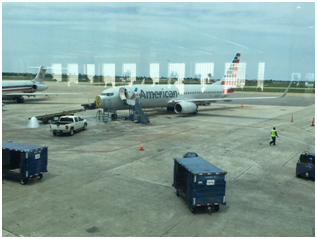
(Photo Robert Tindvall taken from Avherald.com) - 13 April - Guatemala City
Aviateca ATR42, during the initial climb struck a bird at about 8000 ft. that caused damage to the IEP (Ice Evidence Probe); the crew decided to return for landing about 18’ later; - 14 April – Cascais (Portugal)
Aero VIP Do228, on short final a gull impacted the left engine that immediately stopped; the crew selected the propeller into the feather position and continued for a landing; an inspection revealed that the engine's first compressor stage received substantial damage as result of the bird strike and the engine needed to be replaced;
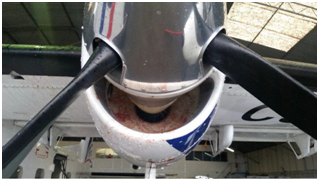
(Photo taken from avherald.com) - 14 April– Between New York and Nashville
Endeavor CRJ 900, enroute at FL380 about 110nm when the crew decided to divert to Charleston reporting a cracked windshield as result of an earlier bird strike.
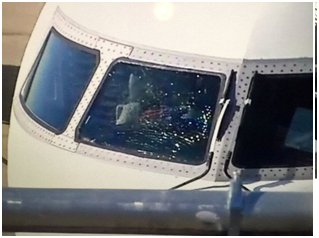
(Photo Jimmy Carter taken from Avherald.com) - 16 April – Venice
Lufthansa A321, rejected take-off after the left engine ingested birds; flight cancelled; - 19 April – Anchorage (AK)
Nippon Cargo Airlines B747, on approach a bird impacted a wing of the aircraft that suffered damage; - 21 April – near Las Vegas (NV)
American Airlines A321, during the initial climb a bird impacted a windshield; the crew initially continued the climb, but stopped at FL190 when the windshield cracked; the crew then decided to divert to another airport; - 21 April – New York (La Guardia)
Endeavor CRJ 900, on final struck a bird that caused damage to the radome; - 24 April – Amsterdam
KLM B747, the aircraft received a bird strike just prior to rotation and the event was communicated to ATC by the crew; in the absence of abnormal indications the crew decided to continue the flight until they decided about 40’ later to return as a precaution after having dumped fuel; - 26 April – Maceio (Brasile)
Avianca Brazil A320, rejected take-off at high speed after an engine ingested a bird; flight cancelled; - 26 April – Isafjordur (Islanda)
Air Iceland FlugfelagIslands Dash 8, rejected take off after a bird impacted one of the propellers; - 26 April – Sao Paulo (Brazil)
TAM A321, during the initial climb the right engine ingested a bird that caused the compressor stall with a loud bang and streaks of flame; immediate return about 15’ later; - 27 April – Seattle (WA)
American Airlines A321, bird strike on rotation; the crew decided to return for landing with a large dent in the nose;
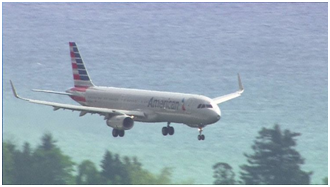
- 29 April – Pemba (Mozambique)
LAM, LinhasAereas do Mocambique ERJ190, was rotating for take-off when a bird was ingested by an engine resulting in a visible streak of flame; the crew checked the engine parameters during the initial climb, in the absence of any abnormal indications the crew decided to continue to destination;a post flight inspection revealed a number of damaged fan blades requiring replacement of the blades; - 4 May – Sao Paulo (Brazil)
Avianca Brazil A320, rejected take off further to a bird strike; flight cancelled; - 5 May - Bhubaneswar (India)
Vistara A320, bird strike during the approach;
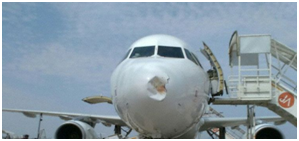
- 7 May – Sacramento (CA)
Hawaiian Airlines B767,on take-off the right engine ingested one or more birds that caused vibrations; immediate return 12’ later; minor damage to the engine; - 8 May – Menorca (Spain)
Niki A320, bird strike on landing; damage to the radome; - 10 May – Lahore
Qatar Airways A330, on approach a bird impacted an engine; return flight cancelled; - 10 May – Phoenix (AZ)
American Airlines A321, during the initial climb at about 8000 ft, a big bird impacted the aircraft; immediate return; a post-flight inspection revealed substantial damage to the fuselage below the windshield; - 14 May – Salt Lake City (UT)
Jetblue A320, during the initial climb a bird impacted the windshield causing minor damage and prompting the crew to return about 30’ later - 16 May – Washington DC (R.Reagan)
Jazz CRJ 200, on final a bird impacted one engine; a post flight inspection revealed damage to an engine cowling; - 20 May – Sao Paulo (Brazil)
TAM LinhasAeras A321, during the initial climb a bird hit the nose cone of the aircraft causing a dent; immediate return about 55’ later; - 21 May – Vilnius
Wizz Air A320, rejected take off at high speed (<100kts) due to a bird ingestion into one engine; - 23 May – Denver (CO) Virgin
America A320, during the initial climb the crew reported a suspected bird ingestion into the right engine and decided to return; after the landing, about 20’ later, an inspection did not reveal anything abnormal to the engine; - 24 May – Washington (DC) R.Reagan
Republic Airways ERJ 175, during the initial climb the left engine emitted a loud bang and streaks of flame prompting the crew to declare emergency, shut the engine down and return to landing; the crew suspected a bird had hit the left hand engine; - 28 May – Calgary
Cargolux B747, in the initial climb a loud bang was heard followed by the stick shaker activating; the airspeed was still alive and safe, however, the indications of the stall margin were missing; the crew continued the climb and assessed the situation then reported a damage to the AoA (angle of attack) vane and decided for a precautionary return;a post flight inspection determined the right hand AoA vane was missing and there was evidence of a bird strike; the AoA vane was replaced; - 5 June – Porto Velho (Brasile)
Latam A320, during the initial climb an engine ingested a bird that caused severe vibrations and strange noises; immediate return; - 7 June – Boise (ID)
Southwest B737, rejected take off due to a bird ingestion into the right engine; fan blades damaged; - 7 June – Gibraltar
British Airways A320, rejected take off at high speed due to the ingestion of a gull into the left engine; flight cancelled; - 12 June – Zurich
Royal Air Maroc B737, probable bird strike on landing; return flight cancelled; - 16 June – Ilheus (Brazil)
Avianca Brazil A319, a vulture struck the nose cone of the aircraft during the approach; next flights cancelled;
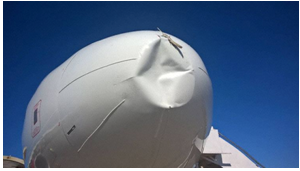
(Photo taken from Avherald.com) - 17 June – Ranong (Thailand)
Nok Air ATR72, during the initial climb a bird struck the captain's windshield; in the absence of any damage or abnormal indications, the crew continued the flight, however, a short time later cracks developed in the captain's windshield prompting the crew to divert to the closest airport - 19 June – Newark (NJ)
American Airlines MD83, during the initial climb hit a bird that caused damage to the pitot tube; immediate return; - 24 June – Istanbul
Turkish Airlines A330, during the initial climb an engine ingested a bird and failed; immediate return; - 24 June – Tomsk
Aeroflot A320, during the initial climb at about 139 ft. a bird was ingested into an engine causing vibrations; the crew continued the climb up to 2000 ft. then decided to return for landing; - 27 June – Kassel
Germania A319, rejected take off at high speed further to a bird ingestion into an engine; - 28 June – Amsterdam
Vueling A320, rejected take off at high speed further to a bird ingestion into an engine; aircraft unable to depart for the flight; - 30 June – Moscow (Domodedovo)
Saratov Airlines ERJ 190, an engine ingested a bird during the final approach;
The final report (http://www.atsb.gov.au/media/5770344/ao2013212-final_report.pdf) on a serious incident involving an Etihad A330 in Brisbane on 21/11/2013 has been published. During the period that the aircraft was at the gate, about two hours, some mudwasps(Sceliphroncaementarium) had built their nest inside a pitot tube of the aircraft blocking it completely. The occurrence then caused the loss of data speed that forced the crew to declare emergency and return to landing.
As usual, ENAC (the Civil Aviation Authority) published the report on their activities developed in the year 2015. Also for that year, the usual laconic page (p. 106) has been dedicated to the wildlife strikes, for large segments fully quoting that of 2014. As the report of the Bird Strike Committee has not been released yet, impacts data are still provisional, as reported in the table below:
| YEAR | <300 ft | Damage | Multiple | Ingestions | With effects |
| 2009 | 620 | 20 | 91 | 13 | 15 |
| 2010 | 719 | 18 | 87 | 14 | 11 |
| 2011 | 802 | 29 | 87 | 19 | 20 |
| 2012 | 961 | 34 | 80 | 25 | 27 |
| 2013 | 982 | 21 | 54 | 21 | 18 |
| 2014 | 961 | 20 | 64 | 20 | 8 |
| 2015* | 953 | 39 | 69 | 43 | 45 |
* Preliminarydata to be verified with those from airport operators
At a first glance, it seems that in 2015 the impacts with damages and with ingestion into the engines are doubled with regard to the 2014, data that, if confirmed, will require careful considerations.
Five episodes occurred during this period (6,14,17 February, 7 and 19 March) where an aircraft crew, following a bird strike and presumably aware of the fact, “ in the absence of abnormal parameters” decide to continue the flight. In three of these cases, the aircraft had to return to the departing airport but in the other two the crew continued the long flight to arrive at their final destination. In all of these cases the aircraft suffered damage from the impact and had to undergo maintenance.
Why does this happen so often notwithstanding, fortunately, the majority of pilots behave in a prudential manner, as you can see from the cases listed below?
There are those who maintain that pilots behaviour is conditioned by the airlines inducing them to continue flying to their destination and limiting diversions or a return to the originating airport only when such options are inevitable. Some think that airlines do not have adequate policies on the issue and abandon the pilots to resolving the problems that arise in these situations. Others believe that it is a lack of awareness of the airlines who consider bird strikes as unavoidable events, easily resolved with good insurance cover and that the problem should be dealt with by the airport operators. The truth probably lies with all three but it is also true that pilots behaviours cannot be considered uniform.
For our part we will continue to sustain that where a problem cannot be resolved with engineering solutions, common rules and procedures that agevolate pilots should be introduced, preferably before a pilot finds himself flying over the ocean and the engine, not manifesting “abnormal parameters” unexpectedly cuts out.
In the meantime it is necessary once again to underline that certification requirements based on a single bird impact are becoming more and more insufficient, the first case verified in 2016 regarded a twin-engine involving ingestion in both engines (9 January). The problem, which has become urgent, is the presence of flocks rather than isolated birds on the approach and departure paths as well as within the airport area. The current engines have behaved very well up to now in terms of resistence and reliability, but the flocks are becoming more frequent and substantial.
- 3 January - Southampton
Flybe ERJ 175, during the initial climb the right engine ingested a bird; immediate return about 30’ later; - 3 January – Saint Louis (MO)
American Airlines MD83, bird strike on final when crossing the runway threshold; minor damage; - 4 January –Wilkes-Barre (PA)
PSA Airlines CRJ 700, multiple bird strike on final; damage to the vertical stabilizer; - 9 January – Sacramento (CA)- Southwest B737
during the initial climb at about 1000 ft flew through a flock of birds; both engines ingested birds; the right engine was running fine, the left with reduced thrust; immediate return about 20’ later; - 9 January – Seoul (Gimpo)
Jin Air B737, during the initial climb an engine ingested a bird and needed to be shut down; immediate return 10’ later; - 9 January – Memphis (TN)
Fed Ex MD10, during the initial climb the tail-mounted engine ingested a bird that caused vibrations; the crew declared emergency and returned 20’ later; - 14 January – Windhoek
Namibia A319, during the approach a large bird hit the fuselage at the right wing root penetrating one of the panels;
http://www.namibian.com.na/index.php?page=read&id=36057
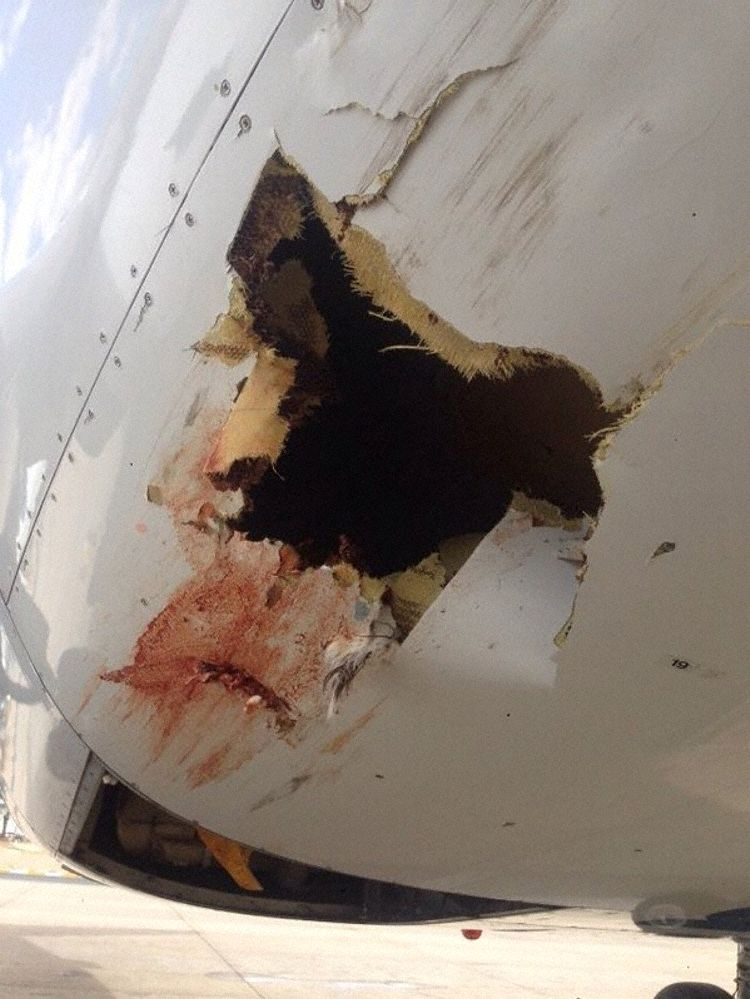
(Photo by Ellen Angel taken from avherald.com) - 24 January – Saint Thomas (Virgin Islands)
Delta B757, during the initial climb the left engine ingested a bird and had to be shut down; the crew decide to land on another airport 25’ later; - 25 January – Orlando (FL)
Jetblue A320, climbing after take-off the crew reported they had a loud bang due probably to a bird strike; the aircraft burned off fuel and returned about 45’ later; - 27 January – Amsterdam
KLM B747, during the initial climb the crew reported that they just had a bird strike on departure, then advised they had engine vibrations; the aircraft entered a short hold, dumped fuel and returned to land about 50’ later; - 1 February – Karachi
PIA ATR 72, bird strike on final, next flights cancelled; - 5 February – Zadar
Croatia Airlines Dash 8, bird strike on approach; next leg cancelled; - 6 February – Istanbul
Turkish Airlines B777, during the initial climb a bird impacted the radome causing a large dent; in the absence of abnormal indications the crew decided to continue the flight to destination in Brazil; however 45’ later they decided to return due to aircraft performance and fuel consumption;
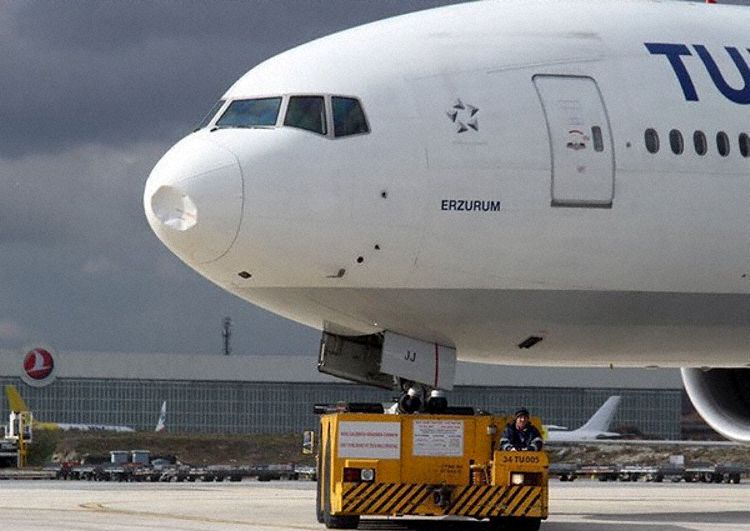
(Photo taken from avherald.com) - 7 February – Brussels
Brussels Airlines A319, during the initial climb an engine ingested a bird prompting the crew to return for landing about 40’ after take-off; - 7 February – Lanseria (Sud Africa)
Kulula Airlines B737, during the initial climb the left engine ingested a Helmeted Guineafowl (Numida meleagris) that caused damage to the fan blades; the crew diverted to Johannesburg about 30’ after take-off;
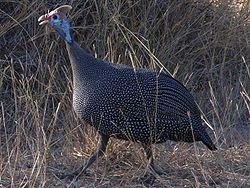
- 14 February – Dublin
Ryanair B737, bird strike upon rotation; in the absence of abnormal parameters the crew continued the climb but then confirmed the bird strike went most likely through the right engine; an inspection reported no bird carcasses were recovered from the runway; the crew decided to return for landing about 35 minutes after departure; - 21 February – Tokyo
Japan Air Lines B767, during the initial climb the right engine ingested a bird; immediate return 20’ later; - 17 February – Dubai
Emirates B777, after take-off a nasty smell of burning feathers was noticed on board believed to be the result of a bird ingestion into an engine; in the absence of any abnormal indications the flight crew continued the flight to destination (Dublin); the aircraft was then declared unable to depart for the return flight, that was cancelled; it remained on the ground until it was positioned to the airline base as a ferry flight two days later; - 22 February – Baltimore (MD)
Southwest B737, bird strike at take-off and immediate return 20’ later; - 23 February – Ronchi dei Legionari (Trieste)
Alitalia A320, rejected take-off after a gull was ingested into one engine causing three bangs; - 26 February – Chicago (IL)
American Airlines MD82, bird strike at take-off that caused damage to the nose and to the fuselage; the crew declared emergency for an immediate overweight landing; - 2 March – Kathmandu
Goma Air Let 410, multiple impact with birds at rotation that prompted the crew to return immediately; despite a bird patrol had chased birds off the runway before departure, however, four birds remained on the runway or immediately returned onto the runway causing damage in the impact to one wing and the horizontal stabilizers; - 2 March – Ercan (Cyprus)
THY B737, rejected take-off at about 120 kt due to a bird strike; the aircraft was released again to service two hours later following checks for suspected ingestion into engines; - 3 March – Amsterdam
Martinair MD11, multiple impact upon rotation that caused vibrations to the left engine; the aircraft dumped fuel and returned to the airport; several carcasses of gulls removed from the runway; - 6 March – Houston (TX)
United Airlines B767, impact at take-off with birds that struck the right side of the aircraft; few minutes later the crew declared emergency due to severe vibrations to the right engine and black smoke reportedly emitted by the engine itself; the aircraft dumped fuel and returned to landing; flight cancelled; - 7 March – Manaus
TAM Linhas Aereas Airbus A350, on take-off a vulture impacted the leading edge of the left wing; the crew continued the flight, however then decided to return about 80 minutes after take-off; an inspection revealed damage and the flight was cancelled;
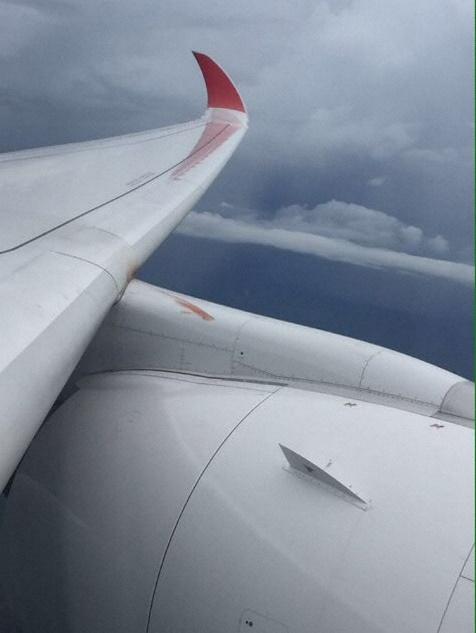
(Photo taken from avherald.com) - 9 March – Bhopal (India)
Air India A319, during the initial climb a bird was ingested into the right engine; the crew shut the engine down and returned for landing; - 10 March – Alicante
Norwegian Air International B737, during the initial climb flew through a flock of gulls receiving several impacts on the wings but not suffering any damage; immediate return 15’ later; - 10 March – Vienna (or Amsterdam)
Easyjet A319, after an uneventful flight from Amsterdam to Vienna, when boarding for the return flight the captain announced the pre-flight inspection of the aircraft found damage to the fuselage and engine as result of a bird strike; the flight was postponed to the next day with another aircraft; - 11 March – London Heathrow
Egyptair B737, during the approach a bird impacted and penetrated the nose of the aircraft; next flight cancelled;
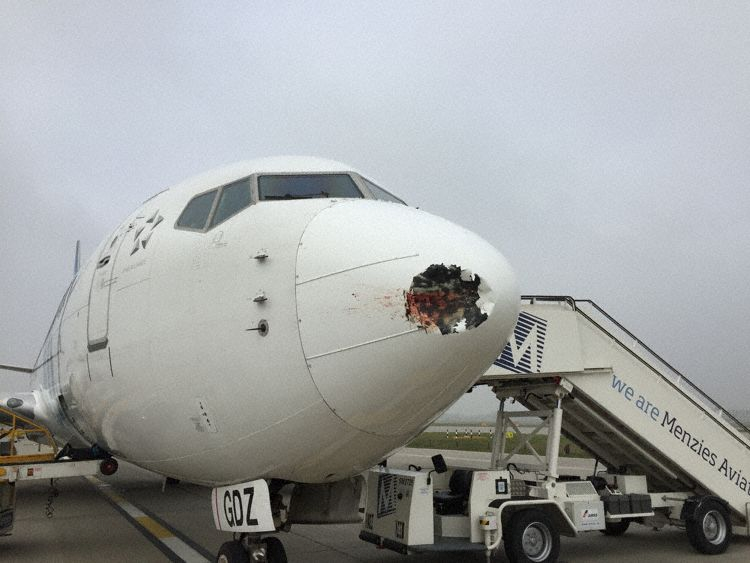
(Photo: Danny James taken from Avherald.com) - 12 March – Rio de Janeiro
Condor B767, bird strike during the initial climb; the crew decided to return about 75’ later; the aircraft was able to depart the following day; - 13 March – Istanbul (Ataturk)
THY B737, during the approach hit a bird that caused damage to the radome; - 17 March – Detroit
Envoy CRJ700, at departure a bird hit the windshield causing minor damage; immediate return and flight cancelled; - 19 March – Johannesburg
Kulula B737, during the climb at about 8000 ft. a bird impacted and penetrated the leading edge of the vertical stabilizer; in absence of abnormal parameters the crew continued to destination where the aircraft was grounded for maintenance;
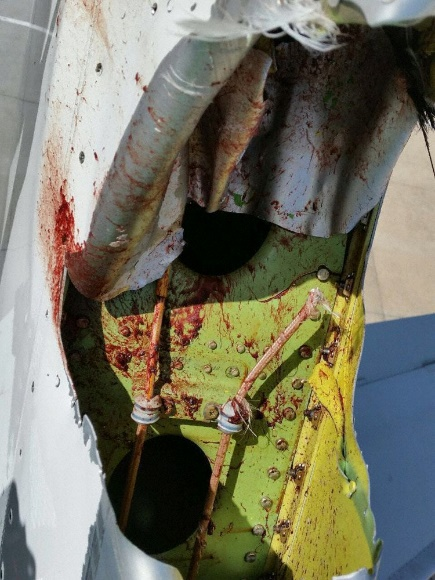
(Details of the point of impact. Photo taken from avherald.com) - 28 March - Beirut
Flydubai B737, on final a bird struck the radome causing damage; the crew decided for a go around and landed safely 20’ later; the radome needed to be replaced; - 28 March – Between Detroit (MI) and Richmond (VA)
Expressjet CRJ 700, a post flight inspection revealed damages caused by a bird during the flight; next flight cancelled;
Each year the prestigious magazine Jane’s Airport Review assigns the ATC Awards to projects and devices that have contributed to improving the safety and efficiency of air traffic. This year the Aerolaser Handheld, proposed by the Bird Control Group, is being considered for one of these awards.
The system is based on laser beams and proved to be a sustainable and animal-friendly bird-repelling device.
Its main feature is the capability of steering birds in a safe and controlled direction, differently from traditional methods which cause birds to flee in uncontrolled directions. Six month tests concluded that the system performs well also in daylight at ranges of 800/1000 mt. and it elicits a reaction from 80% of bird species.
ANSV (National Agency for Flight Safety) released its annual report on its activities and on civil aviation safety in Italy in the year 2015. Also this year few lines (pp.78 and 79) have been dedicated to the bird strike issue while no investigation was initiated for the events occurred in the year under review. The aeronautical press reported at least 13 significant occurrences at Italian airports, that we have mentioned in this website.
